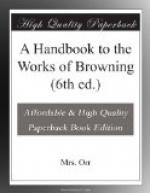The dramas are:—
“Strafford.”
1837.
“Pippa Passes.”
1841.
“King Victor and
King Charles.” 1842.
“The Return of
the Druses.” 1843.
“A Blot in the
’Scutcheon.” 1843.
“Colombe’s
Birthday.” 1844.
“A Soul’s
Tragedy.” 1846.
“Luria.”
1846.
“In a Balcony.”
(A Fragment.) 1853.
The five-act tragedy of “STRAFFORD” turns on the impeachment and condemnation of the man whose name it bears. Its keynote is Strafford’s devotion to the King, which Mr. Browning has represented as the constant motive of his life, and also the cause of his death. When the action opens, England is without a Parliament. The question of ship-money is “burning.” The Scotch Parliament has just been dissolved, and Charles is determined to subdue the Scots by force. Wentworth has been summoned from Ireland to assist in doing so. He is worn and weary, but the King needs him, and he comes.
He accepts the Scotch war against his better judgment: and next finds himself entrapped by the King’s duplicity and selfishness, not only into the command of the expedition to Scotland, but into the appearance of having advised it. Pym has vainly tried to win him back to the popular cause. Lady Carlisle vainly warns him of his danger in subserving the King’s designs. No danger can shake his allegiance. He leads the army to the north; is beaten; discovers that the popular party is in league with the Scotch; returns home to impeach it, and finds himself impeached. A Bill of Attainder is passed against him; and Charles, who might prove by one word his innocence of the charges conveyed in it, promises to do so, evades his promise, and finally signs the warrant for Strafford’s death. Pym, who loved him best, who trusted him longest, is he who demands the signature.
Lady Carlisle forms a plan for Strafford’s escape from the Tower; but it fails at the last moment, and we see him led away to execution. True to the end, he has no thought but for the master who has betrayed him—whose terrible weakness must betray himself—whose fate he sees foreshadowed in his own. He kneels to Pym for the King’s life; and, seeing him inexorable, thanks God that he dies first. Pym’s last speech is a tender farewell to the friend whom he has sacrificed to his country’s cause, but whom he trusts soon to meet in the better land, where they will walk together as of old, all sin and all error purged away.
We are told in the preface to the first edition of Strafford that the portraits are, so the author thinks, faithful: his “Carlisle,” only, being imaginary; and we may add that he regards his conception of her as, in the main, confirmed by a very recent historian of the reign of Charles I. The tragedy was performed in 1837, at Covent Garden Theatre, under the direction of Macready, by whose desire it had been written, and who sustained the principal part.




